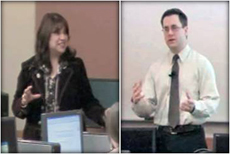What is Case-Based Library Instruction?: Difference between revisions
No edit summary |
No edit summary |
||
| Line 10: | Line 10: | ||
For further discussion of the origin and implementation of the Business Research Clinics and the introduction of case teaching, see Andy Spackman and Leticia Camacho, "Integrated, Embedded, and Case-Based: Selling Library Instruction to the Business School," in ''Librarian as Architect: Planning, Building and Renewing: Thirty-Sixth National LOEX Library Instruction Conference Proceedings'', edited by Brad Sietz, Susann deVries, Sarah Fabian, Suzanne Gray, & Robert Stevens (forthcoming from Ypsilanti, MI: LOEX Press, 2009). You can view the slides from the associated presentation [http://www.loexconference.org/2008/presentations/SpackmanCamachoLOEX08.pdf here]. | For further discussion of the origin and implementation of the Business Research Clinics and the introduction of case teaching, see Andy Spackman and Leticia Camacho, "Integrated, Embedded, and Case-Based: Selling Library Instruction to the Business School," in ''Librarian as Architect: Planning, Building and Renewing: Thirty-Sixth National LOEX Library Instruction Conference Proceedings'', edited by Brad Sietz, Susann deVries, Sarah Fabian, Suzanne Gray, & Robert Stevens (forthcoming from Ypsilanti, MI: LOEX Press, 2009). You can view the slides from the associated presentation [http://www.loexconference.org/2008/presentations/SpackmanCamachoLOEX08.pdf here]. | ||
Andy and Leticia also presented at the KLA/MPLA joint conference in Wichita, Kansas, April 2, 2009, "Case-Based: Selling Instruction to the Business School". To view the slides for this presentation click [[Media:Mpla09.pdf]]. | Andy and Leticia also presented at the KLA/MPLA joint conference in Wichita, Kansas, April 2, 2009, "Case-Based: Selling Instruction to the Business School". To view the slides for this presentation click [[Media:Mpla09.pdf here]]. | ||
See also Andy Spackman and Leticia Camacho, "Rendering Information Literacy Relevant: A Case-Based Pedagogy," ''The Journal of Academic Librarianship'' 35, no. 6 (forthcoming). | See also Andy Spackman and Leticia Camacho, "Rendering Information Literacy Relevant: A Case-Based Pedagogy," ''The Journal of Academic Librarianship'' 35, no. 6 (forthcoming). | ||
Revision as of 16:13, 8 October 2009
Origins
Andy Spackman and Leticia Camacho began experimenting with case teaching at Brigham Young University's Marriott School of Management in September 2007. Without a physical presence in the business school we spend much of our effort on outreach, for which library instruction has proven most effective. By 2007 we were conducting over 120 instructional sessions per year, with over 3,000 participants. These sessions were primarily integrated into specific courses, including a mandatory session in the communications class required of all business school students. And yet students continued to express a need for additional opportunities for formal library instruction in specific topics. To meet this need we launched a series of extracurricular, open-door clinics modeled after the clinics at The Home Depot stores. (See a schedule of recent clinics here.)
These "Business Research Clinics" have been a success, with 637 students and faculty attending 48 clinics during the first two years. Our approach evolves as we learn more about promoting library instruction where attendance is voluntary, and based on early student feedback we began to use cases in our teaching. The case method is familiar to business students who commonly encounter it in their regular coursework. Adapting this pedagogical model to library instruction has made us much more effective in connecting with our students and faculty and makes principles of information literacy more relevant to them.
Attendee satisfaction ratings for clinic content average almost 5% higher for clinics taught using the case method, and an independent samples t-test shows that this increase is statistically significant at a 95% confidence level. Anecdotal evidence has also been encouraging, with both students and faculty specifically commenting on the value added by the case method. We continue to research the impact of case teaching and will add citations for our findings as they are published.
For further discussion of the origin and implementation of the Business Research Clinics and the introduction of case teaching, see Andy Spackman and Leticia Camacho, "Integrated, Embedded, and Case-Based: Selling Library Instruction to the Business School," in Librarian as Architect: Planning, Building and Renewing: Thirty-Sixth National LOEX Library Instruction Conference Proceedings, edited by Brad Sietz, Susann deVries, Sarah Fabian, Suzanne Gray, & Robert Stevens (forthcoming from Ypsilanti, MI: LOEX Press, 2009). You can view the slides from the associated presentation here.
Andy and Leticia also presented at the KLA/MPLA joint conference in Wichita, Kansas, April 2, 2009, "Case-Based: Selling Instruction to the Business School". To view the slides for this presentation click Media:Mpla09.pdf here.
See also Andy Spackman and Leticia Camacho, "Rendering Information Literacy Relevant: A Case-Based Pedagogy," The Journal of Academic Librarianship 35, no. 6 (forthcoming).

